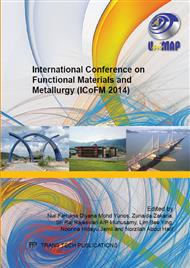p.251
p.256
p.262
p.268
p.274
p.280
p.284
p.290
p.295
Effect of Microwave and Conventional Heating on Sintering Behavior of Cu-10vol.%SiC Nanocomposites
Abstract:
Effect of heating mode and sintering temperature on sinterability of ex-situ Cu-10vol.%SiC composites was investigated. The Cu and SiC powder mixture were mechanically alloyed for 5 hours at 100 rpm in a planetary ball mill under argon atmosphere. The as-milled powders of Cu-10vol.%SiC were compacted and sintered in conventional tube furnace and microwave furnace at 700°C, 800°C, and 900°C. Microwave reduces the processing time significantly along with higher heating rates when compared to conventional tube furnace. Based on XRD result, the average Cu crystallite size is 80.49 nm after milling and its value remained under 100 nm after sintering. Microwave gave relatively smaller crystallite size than tube furnace. SEM revealed the homogeneous distribution of SiC particles in the Cu matrix in both heating mode. Relatively higher densification parameter was obtained by microwave furnace sintered at 900°C. This temperature was defined as an optimum sintering temperature and microwave sintering was claimed to exhibit much better sinterability than conventional tube furnace sintering.
Info:
Periodical:
Pages:
274-279
Citation:
Online since:
June 2015
Authors:
Keywords:
Price:
Сopyright:
© 2015 Trans Tech Publications Ltd. All Rights Reserved
Share:
Citation:


